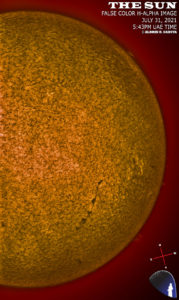Here are today’s solar images taken from Al Sadeem Observatory, February 10, 2018.
The sky was mostly clear with light air turbulence making the seeing and transparency good at the time these images were taken.
Generally, low solar activity was observed over the past 24 hours. Space weather agencies reported several B-class flares erupted from the lone visible sunspot group AR2699. It showed some signs of structural decay in the trailer spots and obtained simpler beta (bipolar) magnetic configuration. About an hour after these images were taken, it produced a C-class solar flare. Since AR2699 is situated near the center of the Sun’s disk, the flare was Earth-directed and affected Earth through brief weak radio satellite communication disruptions in the South American peninsula. The latest sunspot number (based on visual count and Wolf number calculation) is 23. Small filaments, prominences and flaring activity from AR2699 were distinctively captured in H-alpha imagery.
Space weather agencies* forecast solar activity to remain at low levels with chances of B-class to C-class solar flares. The extent of the frequency and intensity of the Sun’s activity will highly depend on the magnetic flux fluctuations happening in the visible ARs in the coming days. Close monitoring is being conducted by numerous space weather agencies for any significant development.
*Technical reports courtesy of Solar Influence Data Center (SIDC), NOAA-Space Weather Prediction Center (NOAA-SWPC)








